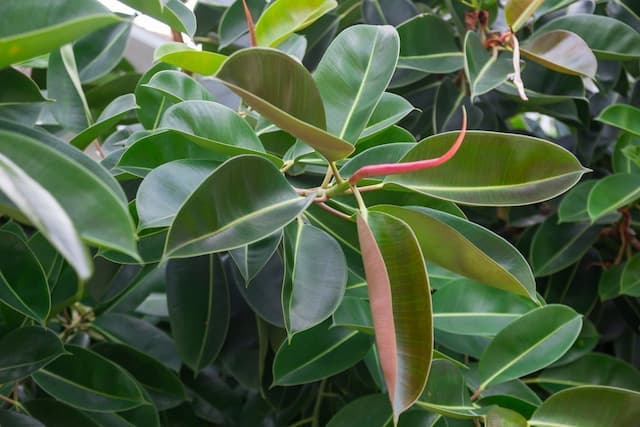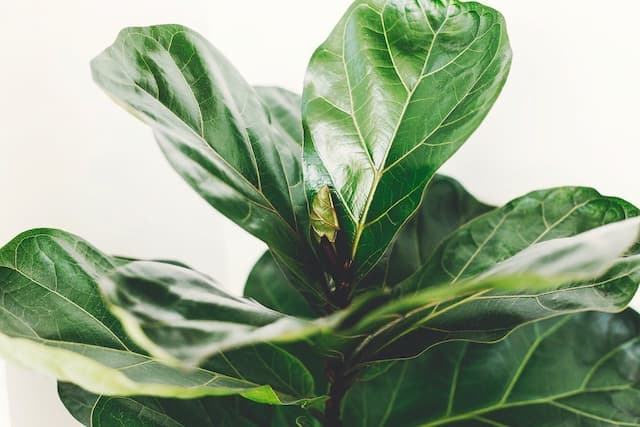Fig Ficus carica 'White Marseilles' (F)

ABOUT
The White Marseilles Fig is a type of fig tree known for its attractive foliage and delicious fruit. This plant bears large, deeply lobed leaves that are a rich green color with a sturdy, prominent vein structure that gives them a textured appearance. Its leaves create a lush, tropical effect. The fruit of the White Marseilles Fig is its most remarkable feature. The figs are a beautiful, creamy white to pale green color when they mature. They are typically medium to large in size with a sweet, rich flavor that is highly prized. The skin of these figs is thin with a soft texture, and inside, the flesh is a strikingly vibrant shade of pinkish-red with numerous small seeds giving it a slight crunch. The White Marseilles Fig blooms with small, inconspicuous flowers that are actually hidden inside what becomes the fruit itself. This unique flowering trait is characteristic of fig trees. The plant has a pleasing overall shape and can become quite a statement in the landscape with its broad canopy of large leaves and its bountiful fruit production, which can be quite heavy when the plant reaches maturity. In general, the plant exudes a classic Mediterranean vibe and is often associated with sun-drenched climates, evoking a sense of abundance and the sweetness of summer.
About this plant
 Names
NamesSynonyms
White Marseilles Fig, Marseilles Fig.
Common names
Ficus carica 'White Genoa', Ficus carica 'White Marseille'.
 Toxicity
ToxicityTo humans
The common fig plant is generally not toxic to humans when the fruit is consumed ripe. However, the sap of the fig plant contains ficin and psoralen, which can cause skin irritation or phytophotodermatitis in some individuals, especially when exposed to sunlight after contact. It's important not to ingest the leaves or sap because that could potentially cause irritation of the gastrointestinal tract, leading to symptoms like nausea, vomiting, or diarrhea. But eating the fruit of the common fig, including the 'White Marseilles' fig, is typically safe and does not lead to poisoning.
To pets
The common fig is considered to be of low toxicity to pets. However, the sap of the fig contains ficin and psoralen, which can be irritating. If pets come into contact with the sap, it can cause dermatitis or skin irritation. Ingestion of large amounts of fig leaves by pets might lead to gastrointestinal upset, including vomiting, diarrhea, or salivation. The ingestion of the fruit itself is generally not a problem, but moderation is key to prevent any potential stomach upset due to the fiber content.
 Characteristics
CharacteristicsLife cycle
Perennials
Foliage type
Deciduous
Color of leaves
Green
Height
10-30 feet (3-9 meters)
Spread
10-20 feet (3-6 meters)
Plant type
Tree
Hardiness zones
7
Native area
Western Asia
Benefits
 General Benefits
General Benefits- Edible Fruit: The White Marseilles fig produces sweet, delicious fruit that can be eaten fresh, dried, or used in cooking and baking.
- Shade Provider: With its large leaves, the fig tree offers a generous amount of shade, making it a great addition to gardens and outdoor seating areas.
- Aesthetic Appeal: The tree adds ornamental value to the landscape with its attractive foliage and architectural branching pattern.
- Low Maintenance: Fig trees are known to be hardy and require minimal care once established, making them suitable for gardeners of all skill levels.
- Wildlife Attraction: The fruit attracts birds and other wildlife, providing a natural way to enjoy and support local ecosystems.
- Drought Tolerance: Once established, White Marseilles fig trees are quite drought-tolerant, making them suitable for xeriscaping and water-wise gardening.
- Long-Lived: Fig trees can live for many years, providing enduring benefits to the garden and property.
- Soil Enrichment: The tree's root system can help to prevent soil erosion and enrich the soil with organic matter as leaves fall and decompose.
 Medical Properties
Medical Properties- Antioxidant activity: The figs of the Ficus carica species contain antioxidant compounds that can help to neutralize free radicals in the body.
- Anti-inflammatory effects: The plant's fruit extracts may reduce inflammation, which can be beneficial for inflammatory conditions.
- Laxative properties: Figs have traditionally been used to aid in digestion and alleviate constipation due to their high fiber content.
- Antidiabetic potential: Some studies suggest that fig leaf extracts may have a positive effect on blood glucose levels.
- Antimicrobial action: The sap and other parts of the plant have shown antimicrobial properties against certain bacteria and fungi.
- Prebiotic function: Figs can act as prebiotics, supporting the health of beneficial gut bacteria.
- Skin health: Ficus carica extracts are sometimes used in skincare products for their potential hydrating and antioxidant effects.
- Wound healing: Traditional uses include the application of fig fruit or leaves to wounds to promote healing.
 Air-purifying Qualities
Air-purifying QualitiesThis plant is not specifically known for air purifying qualities.
 Other Uses
Other Uses- The leaves of the fig tree can be used as a natural dye for fabrics, giving them a light yellow to brown color depending on the mordant used.
- Fresh fig leaves can be used in cooking as a wrap for grilling fish, meat, or vegetables, imparting a smoky-sweet flavor to the dish.
- Dried fig leaves can be turned into a tea which has a coconut-like flavor and is enjoyed for its unique taste.
- The latex from the fig tree is sometimes used as a natural garden pesticide due to its irritating properties to insects.
- Figs can be used to make a natural and biodegradable scrub by blending dried figs with other ingredients, useful for exfoliating skin.
- Fresh or dried figs can serve as a natural sweetener in baking, replacing refined sugars in recipes like cakes and cookies.
- The wood of the fig tree can be crafted into utensils or ornamental objects, often appreciated for its smooth grain.
- Ficus carica wood can be used as a source of fuel, burning well and providing a good source of heat.
- The fig tree's bark can be processed and used in the production of durable paper products.
- Ripe figs, when crushed, can act as a gentle and natural hair conditioner, giving shine and softness to the hair.
Interesting Facts
 Feng Shui
Feng ShuiThe Common Fig is not used in Feng Shui practice.
 Zodiac Sign Compitability
Zodiac Sign CompitabilityThe Common Fig is not used in astrology practice.
 Plant Symbolism
Plant Symbolism- Fertility and Abundance: The common fig, including Ficus carica 'White Marseilles', carries the symbolism of fertility and abundance due to its prolific fruiting tendencies and the nutrient-rich figs it produces.
- Knowledge and Enlightenment: Figs are historically associated with knowledge and enlightenment because of their connection to the Biblical story of Adam and Eve, in which they realize their nakedness and clothe themselves with fig leaves.
- Peace and Prosperity: In many cultures, fig trees are seen as symbols of peace and prosperity, likely stemming from their ability to produce fruit for extended periods, thus providing sustained sustenance and economic stability.
- Longevity and Resilience: The fig tree is known for its longevity and resilience, often growing in challenging environments and living for many years, hence symbolizing strength and the ability to overcome adversity.
 Water
WaterFor the common fig tree, water it deeply once a week during the growing season, providing about 1 to 1.5 gallons of water each time depending on the size and age of the tree. Adjust the amount during extremely hot or dry periods by watering twice a week. During the winter months, reduce watering since the plant is dormant and only water every two to three weeks, or when the soil is dry to the touch a few inches deep. It's essential not to overwater as that can lead to root rot.
 Light
LightThe common fig tree thrives in full sun conditions, meaning it requires at least 6 to 8 hours of direct sunlight daily for optimal growth and fruit production. Position it in a spot where it is exposed to unfiltered sunlight throughout the day for best results.
 Temperature
TemperatureThe common fig tree tolerates a range from about 15 to 100 degrees Fahrenheit, with ideal growing conditions between 60 to 85 degrees Fahrenheit. It can tolerate colder temperatures down to about 15 degrees Fahrenheit briefly, but sustained cold can damage the plant.
 Pruning
PruningPrune the common fig tree in late winter before new growth begins to remove any dead or diseased wood and to shape the tree. Pruning is essential for promoting a sturdy structure, good air circulation within the canopy, and to enhance fruit production. The best time for heavy pruning is when the plant is dormant, but light pruning can be done throughout the year as needed.
 Cleaning
CleaningAs needed
 Soil
SoilThe common fig (Ficus carica 'White Marseilles') requires well-draining soil with some organic matter for nutrients. A mix incorporating one part garden soil, one part compost, and one part perlite or sand would be suitable. The soil pH should be between 6.0 and 6.5.
 Repotting
RepottingCommon figs, including the variety 'White Marseilles', should be repotted every 2-3 years to replenish nutrients and prevent the root system from becoming pot-bound, in turn ensuring healthy growth.
 Humidity & Misting
Humidity & MistingCommon figs such as Ficus carica 'White Marseilles' are adaptable to a wide range of humidity conditions and do not require high humidity; average room humidity is generally sufficient.
 Suitable locations
Suitable locationsIndoor
Place in bright, indirect light and keep soil moderately moist.
Outdoor
Plant in full sun to partial shade; protect from harsh winds.
Hardiness zone
7-11 USDA
 Life cycle
Life cycleThe common fig (Ficus carica 'White Marseilles') starts its life as a seed, which upon germination in favorable conditions, grows into a small seedling. As the seedling matures, it develops a strong root system and a woody stem, becoming a sapling. This sapling further grows, entering a vegetative stage where leaves expand to form a broad crown, and the plant undergoes annual cycles of growth. During its reproductive stage, the fig produces unique flowers inside a structure called a syconium, which is pollinated by specific fig wasps. Following successful pollination, the plant yields edible fig fruits that reach maturity, typically ripening from midsummer to fall. As a perennial, the common fig can live and produce fruit for many years, with some trees living for several decades under optimal conditions.
 Propogation
PropogationPropogation time
Early spring
The most popular method for propagating Ficus carica 'White Marseilles', commonly known as the Common Fig, is through cuttings. This technique is typically done in late winter to early spring, when the tree is still dormant. Hardwood cuttings of about 8 to 10 inches (20 to 25 centimeters) long and pencil-thickness are taken from healthy branches. The bottom end of the cutting is dipped in rooting hormone to encourage root development and then planted in a pot with well-draining soil, burying about half the length of the cutting. The soil is kept moist but not waterlogged, and the pot is placed in a warm, bright area but not in direct sunlight. Roots typically develop within a few weeks, after which the new fig plant can eventually be planted out in its permanent location.




